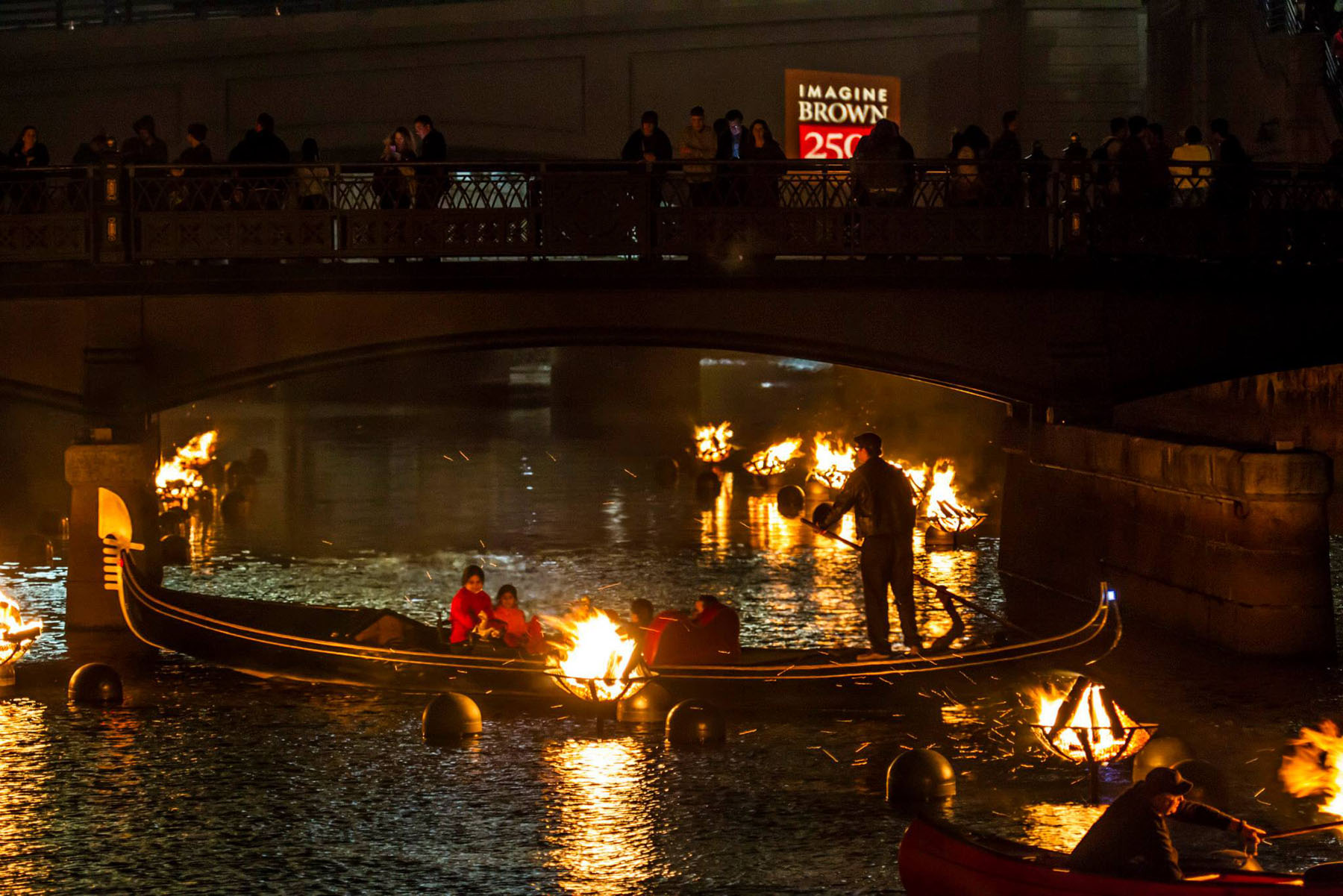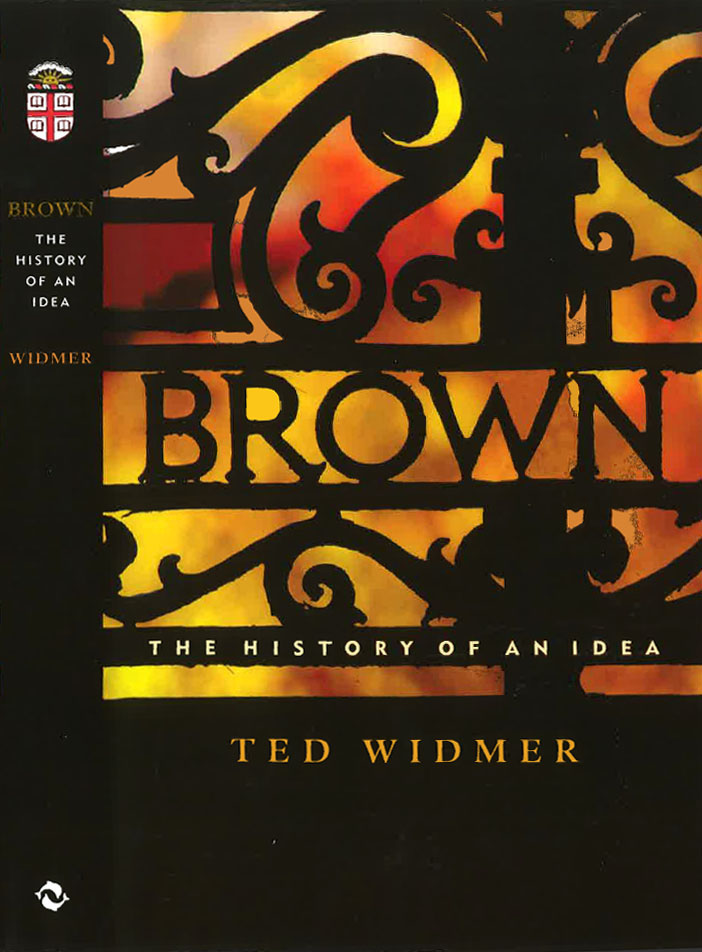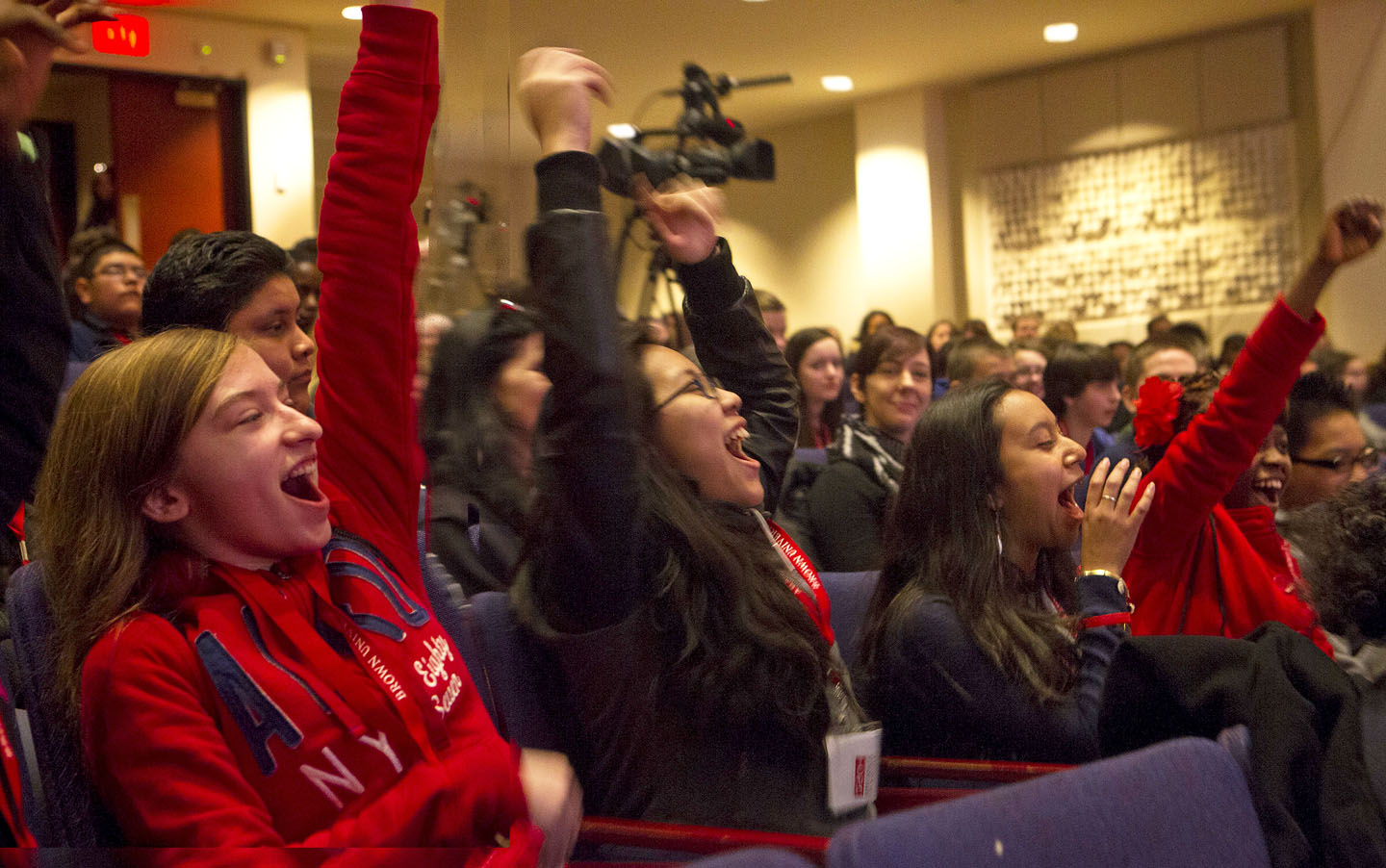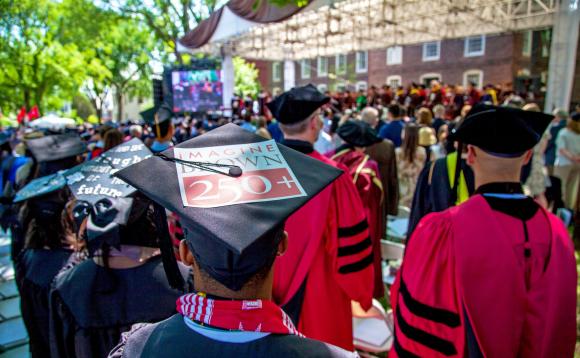PROVIDENCE, R.I. [Brown University] — For 444 days, thousands of revelers from around the world came together to celebrate Brown’s 250-year history. They converged on College Hill as local community members, alumni, students, parents, and friends, traveling from near and far to take part in tours, exhibitions, performances and parties, and even took the celebration beyond the gates, to fetes around the world. They reflected on the University’s rich past, while also examining the Brown of today and tomorrow.
It all came to a close at the 247th Commencement in May with several days of events, including Campus Dance fireworks, a special lighting of WaterFire in downtown Providence, forums, and the red, white, and brown street-striping of College and Benefit streets, lined especially for Sunday morning’s Commencement procession.

Evidence of Brown’s semiquincentenary was hard to miss: banners on buildings, signs on streetlamps, logos on varsity uniforms, decorations hovering above WaterFire, the iconic civic artwork of Brown graduate Barnaby Evans. Photo: Mike Cohea/Brown University
And as the weekend came to a close, there was one final surprise to finish off the 15 months of celebration: The premiere performance of Alma Mater 250, a modernized version of Brown’s Alma Mater.
Written by music department chair Butch Rovan and performed by seven graduating Brown/Trinity MFA students and one Brown undergraduate, as well as locally based international blues and swing revival band Roomful of Blues, Alma Mater 250 was a spirited mingling of past and present, a fitting end to the 250th anniversary celebration.
Prior to the performance, in a rare break from tradition, President Christina Paxson took a moment to reflect on the end of the anniversary celebration.
“In myriad ways over the last 15 months, we have reflected on our past, considered the University of today and challenged ourselves to imagine Brown’s future,” Paxson said. “From the start, we set a tone that was uniquely Brown, and that spirit has continued throughout the anniversary. ... We have showcased the best of Brown and the diversity that thrives in the Brown community and defines the Brown difference.”
A celebration for the ages
Brown kicked off its semiquincentenary celebration in March of 2014 with a weekend of events that brought thousands to campus.
Middle schoolers from more than 30 local schools arrived on campus early that Friday for a day of discovery that included robot demonstrations, playing in the virtual reality Cave, and lunch in the Ratty.
Notable alumni, including World Bank President Jim Yong Kim and U.S. Secretary of Labor Thomas Perez, returned to campus for lectures and forums, while departments across campus opened their doors to the public to offer demonstrations about their scholarly work. The weekend also included a Friday night party complete with a 600-pound cake and fireworks above University Hall.
From the whimsical to the academic, the goal of the weekend, and ultimately the entire 15-month celebration, was to showcase Brown’s diverse strengths, while also including as many people as possible, from local community members, to University alumni, parents, and friends.
“It was really a great challenge to create and support new programs, as well as weave the 250th into things that were already happening,” said Eve Ornstedt, executive director of the 250th. "Our primary goal was to create meaningful engagement and varied connections across the community."
All together now
The spring of 2014 also saw the publication of The Brown Reader, a collection of essays, comics, and poems by 50 alumni writers, poets, and artists reflecting on their time on College Hill.
Published by Simon and Schuster, the book was one of many ways in which the 250th Steering Committee strived to bring alumni into the celebration and promote the sense of inclusivity that remained one of the main goals of planning the anniversary events, according to Ornstedt.
A survey went out several months before the opening celebration asking for input on the best way for the global community to celebrate, and several ad hoc committees were formed within the 250th Steering Committee to ensure that as many departments and groups on campus as possible were included.
From billboards along the highways, to ads in the airport welcoming arrivals, to the banners that lined the streets around College Hill, it was all about spreading the spirit of celebration and inviting as many people as possible, from the Brown community and beyond, to take part.

The University’s semiquincentenary “Birthday in a Box” outreach brought supplies that supported an anniversary celebration among researchers in Antarctica.
The party extended well beyond Providence, with more than 100 alumni clubs from around the world and all seven continents holding “Birthday in a Box” fetes. Groups as far away as Asia and Australia, and even a group of faculty members doing research in Antarctica, received packages complete with 250+ decorations and ideas for ways to celebrate the University’s founding.
The creation of Alma Mater 250 was another way to integrate the local community, with the participation of Roomful of Blues at the Commencement première.
Using the James Andrews DeWolf-penned lyrics from the original Alma Mater, Rovan gave the music an upbeat, blues-inflected sound in which the Brown community will still sense the original version. The original bridge, which begins “The happiest moments of youth’s fleeting hours,” was replaced with three rap verses written and performed by undergraduate student Sebastian Otero.
“I always thought it would be neat to reinterpret the Alma Mater in a more modern way. When I began the project, I wanted it to be something that was uplifting and had a lot of energy, and unconsciously I drifted toward something that was kind of R&B/gospel,” Rovan said, reflecting on his creation. “I was so thrilled that I had a chance to do this. It was such a blast and amazing to be a part of bringing something like that to graduation and the 250th. The energy that these musicians and singers brought to it was incredible.”
History repeated
While much of the 250th celebration focused on the present, the history of the University was naturally a major focus over the last 15 months as well.
“It wasn’t about telling one Brown history,” Ornstedt said, “but representing and including many voices and communities in telling Brown's broad and varied history.”
The Brown 250+ website launched in the spring of 2014 complete with stories from Brown’s history and an interactive timeline that starts prior to the University’s founding and even includes the oldest known motion picture of Brown’s Commencement ceremony — footage that was discovered at the Rhode Island Historical Society.
“We surfaced information and digitized content that may have not had a chance to be seen were it not for this celebration,” Ornstedt said.
The 250th website is also filled with a compilation of anniversary-inspired social media engagement from the last 15 months, a modern-day record that will no doubt be a significant part of the next chapter in Brown’s history.
 More recently, Ted Widmer, author and historian, completed Brown: The History of an Idea, a photo-filled book that chronicles the University’s origins and explains many of its traditions. (The book is available exclusively at the Brown Bookstore until national publication in the fall.)
More recently, Ted Widmer, author and historian, completed Brown: The History of an Idea, a photo-filled book that chronicles the University’s origins and explains many of its traditions. (The book is available exclusively at the Brown Bookstore until national publication in the fall.)
History was quite literally on display several times throughout the 250th celebration, with the opening of several exhibitions, including The Lost Museum, put together by public humanities students to bring back to life Brown’s Museum of Natural History and Anthropology and its founder John Whipple Potter Jenks, as well as the Haffenreffer Museum’s exhibition In Deo Speramus: The Symbols and Ceremonies of Brown University, and 25 Objects: The Stories of Our Past, Present and Future.
There was even a return to Brown’s literal beginnings, with a May 2015 event at the Baptist Church in Warren, R.I., the original site of what was then called the College of Rhode Island.
It was important to the Steering Committee that an honest account of Brown’s history be presented, with plenty of the celebratory high points, but also some of the challenges that have faced the University over the years.
In September 2014, as part of a weekend of 250th events, more than 300 University guests assembled on the Front Green for the dedication of the Slavery Memorial, a work by the American sculptor Martin Puryear that was commissioned on the recommendation of the 2006 Final Report of the Steering Committee on Slavery and Justice. The report was an investigation of the University’s historical relationship to slavery and the transatlantic slave trade.
The following month, the University dedicated the new home of the Center for the Study of Slavery and Justice, on Waterman Street, which hosted an inaugural exhibition titled Black Experiences at Brown.
Another exhibition and weekend of events, hosted by the Pembroke Center, looked back on Louise Lamphere v. Brown University, the landmark class action case that in 1975 charged Brown with sex discrimination and set in motion a chain of events that changed the University. Events include an exhibition, panel discussion, and symposium. Lamphere, a former member of the Brown faculty, was awarded an honorary doctorate at this year’s Commencement ceremony.
Classroom and Campus
Excellence, both inside and outside the classroom, was showcased throughout the celebration in a variety of ways. Dozens of academic departments and student and community groups were awarded grants by the 250th Steering Committee to help fund anniversary-related events throughout the year. Those ranged from a Save The Bay tour of what Narragansett Bay and its shoreline would have looked like two and a half centuries ago, to the 50th anniversary celebration of the Brown-Tougaloo partnership in November 2014.
Beyond the classroom, the Steering Committee made sure to include other campus groups, like the University’s athletes, in the celebration. Each sports season, one male and one female athletics team was given vintage-style uniforms to wear, and the history of the Brown Bear mascot and its traditions were chronicled on the 250th website.
And during the March 2014 opening celebration, the Brown University Wind Symphony presented a concert featuring the world premiere of Brownian Motion by Patrick Zimmerli, a work commissioned in celebration of the University’s anniversary.

Students from more than 30 middle schools visited Brown for a Day of Discovery, part of the 250th anniversary kickoff. “Best field trip ever!” one of them tweeted. Photo: Mike Cohea/Brown University
A living legacy
The 250th celebration will live on in many ways: Through the social media captured on the 250th website, the archival materials dug up and exhibited over the last 15 months, the memories of the local middle schoolers who came to campus for a day on that opening weekend. On June 11, an elm will be planted on the College Green as a way to commemorate the celebration and to thank everyone — the staff, faculty, facilities personnel, students, alumni, parents, and community members — who helped make it all possible.
Perhaps most importantly though, now that the exhibitions, events, performances, and lectures have come to a close, the last firework has fizzled out and the last piece of cake has been consumed, Brown’s past, present, and future will carry on most vividly in the minds and hearts of its students, a development of which President Paxson reminded the audience in her remarks at Commencement.
“As you pursue your lives of usefulness and reputation, I hope the last 15 months have helped prepare you to do so with a deeper sense of pride and a fuller understanding of Brown’s history and of those who have journeyed the path before you.”
As the verses of Alma Mater 250 passed over the College Green to close out Commencement and the 250th celebration, that sentiment was echoed one last time in Otero’s rap lyrics, only moments before Brown’s newest graduates stepped off the Green as they, and the University, moved into the next chapter of their histories:
Was it all a dream?
The happiest moments of our lives under the shade of these trees
All the smiles in these memories pass quick like a summer breeze
Pass down traditions and give it to the homies.

